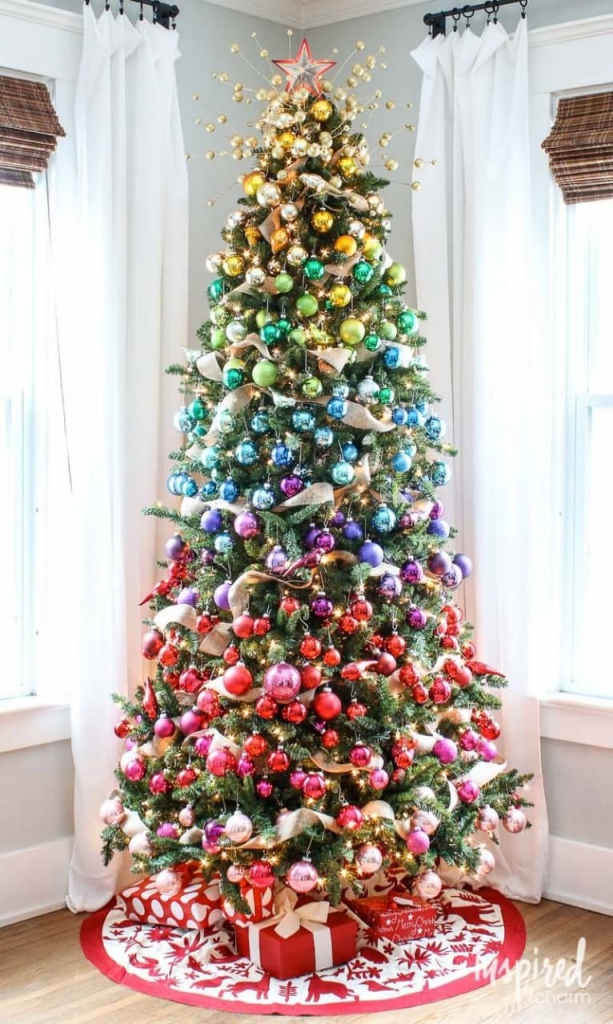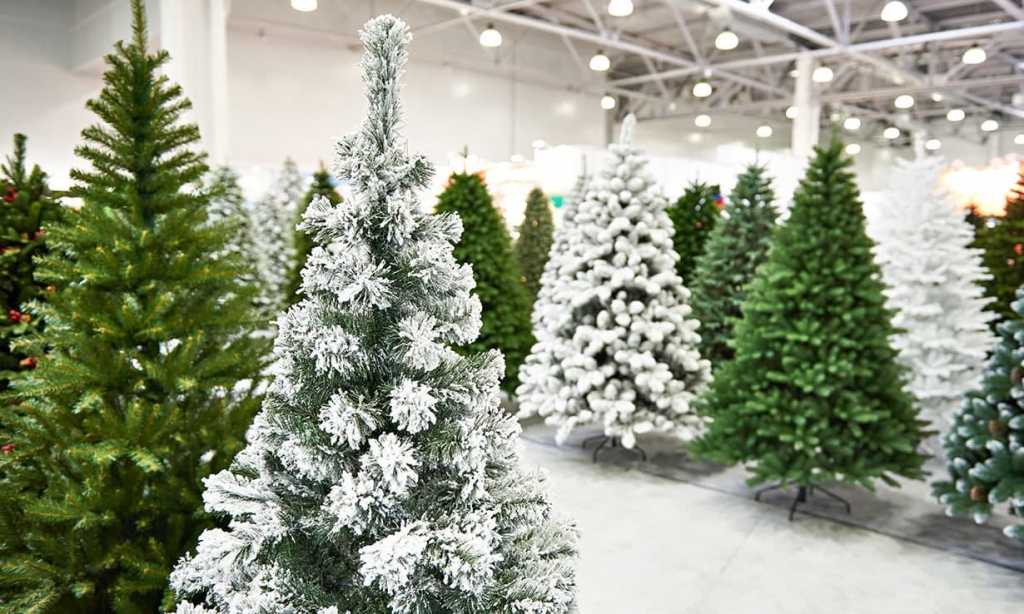
As winter approaches, the last bell tolls, signaling the end of the year. Everyone is looking forward to the start of the new year and making the most of the days and months ahead. Iranians, according to their traditions, prepare the Haft-e-Sin in the latter days of March; nevertheless, plans varied among Christian compatriots. They adorn the Christmas tree, which is like an emerald that shines in the lifeless winter environment, in the streets and residences, and heralds the arrival of green spring days, according to their traditional practice. Christmas trees, with their brilliant decorations and appealing ornaments, are undeniably one of the most popular symbols that herald the arrival of the new year.
Many of us are stunned by the red, white, and gold ornaments when we see the glittering Christmas trees and instantly take a photo to save this remarkable beauty. But how much do we truly understand about the Christmas tree? What is the purpose of putting up this tree and decorating it? Why did Christians select this symbol to usher in the new year? Today, we shall become more acquainted with this appealing and beautiful symbol and investigate its significance. Stay with Romadon.
What is Christmas Tree ?
Christmas is an international Christian holiday that is observed every year at the start of the New Year. This delightful celebration begins on December 24 or 25 and lasts around 12 days. Of course, it has been several years since the elders of Christianity decided that December 25 would be the beginning of Christmas, and since then the same date has been officially considered; however, it can still be seen that in some countries, December 24 is considered the original time of this holiday.
Everyone is rushing to get ready for the new year a few months before Christmas. One of the most essential things to do before Christmas is to decorate the house to signal the arrival of the New Year and this wonderful holiday. We’ve all seen the green, crimson, gold, and white Christmas decorations, and we know they are the symbols of this holiday; evergreen conifer and pine green trees are also key elements of this holiday, and participants in this worldwide event adorn these trees with zeal.
Evergreen conifer, pine, and sometimes fir trees are adorned with various decorations before to the start of Christmas. Colored chocolates and candies, little lights, stars, angels, flowers, ribbons, sweets, and other decorations are now used to enhance the appearance of the tree. In general, they utilize decorations that represent the start of spring, gladness, and the birth of Jesus Christ. The Christmas tree was originally adorned with candles to represent the birth of Jesus Christ and the enlightenment of the world as a result of his existence; however, with the growth of technology and the accidents caused by candles, LED lights replaced them. Artificial trees are still utilized today due to the difficulties of transporting actual trees in highly populated places. These fake trees, which are usually constructed of PVC, are popular all around the world.
Continue reading to discover more about the Christmas tree’s history and its unique decorations.
The history of Christmas tree :

For a long time, people valued trees that stayed green and lively during the winter. Branches of these trees are supposed to have been affixed to the doors and windows of dwellings in ancient times so that their freshness and vigor may permeate people’s lives. This is why, in old photographs, the Christmas tree was sometimes hung upside down from the ceiling, and they were sometimes hanged with chains in the middle of the rooms to operate as a chandelier. Over time, it was thought in certain cultures that the presence of green branches and leaves during the winter cleanses evil and voodoo, thus the branches and leaves, as well as lush trees such as evergreen conifer, fir, pine, and so on, have a particular position among people all over the world.
Green winter trees have gained many meanings throughout history, for example, they have been seen as a sign of perpetual life, while they have been regarded just for their beautiful element. It is uncertain when the Christmas tree became popular, although trustworthy historical sources place it around 1000 years ago. The first Christmas tree was most likely used in Britain; nevertheless, other sources also credit Germany and the Republic of Latvia as the genesis of the Christmas tree.
Some historians say that the Christmas tree was worshipped approximately 1600 years ago; nonetheless, it had nothing to do with Christianity and belonged to the ancient Egyptians, Chinese, or Hebrews. There is also evidence that Scandinavian pagans utilized cedar trees throughout the winter, suggesting that the Christmas tree may have been transferred to Christianity from another faith. Several historical writings also describe a tree known as the “Paradise Tree” during the Middle Ages.
Let’s look at the culture of the Christmas tree in different nations to discover more about its history :
Estonia, Latvia and Germany :
Christmas tree decoration traditions may have originated during the Renaissance in northern Germany and Latvia. There is a lot of evidence that the Christmas tree was adorned as it is now in Latvia around 1441, 1442, 1510, and 1514 AD. Latvians are claimed to have utilized these adorned trees in the majority of their celebrations and dances; nevertheless, these trees were much smaller than modern Christmas trees. Surprisingly, during the 18th century in Germany, Christmas trees were placed in barracks to cheer up army soldeirs, and this eventually spread across the towns. The existence of these trees, as well as the government’s care to troops’ conditions, was one of the reasons for the German army’s popularity at the time.
The use of the Christmas tree became quite popular among the nobility in the nineteenth century, and it was frequently utilized in Austria, Denmark, and France. Gradually, the usage of decorated Christmas trees grew popular among the lowest levels of society, and they may still be seen in the streets throughout the Christmas season. The first documented use of this tree in the United States was in 1836. There are several references to the Christmas tree, which still remains, throughout nineteenth-century American novels and short tales. According to these accounts, they even utilized apple and cherry trees and their branches on occasion.

Georgia :
Georgians have their own Christmas tree, known as Chichilaki. This tree is fashioned with dried hazelnut or walnut tree branches. Chichilacs range in height from 20cm to 3m. The Georgians believe that their tree should resemble St. Basil of Caesarea’s beard. Basil was an archbishop who resided in Caesarea, Anatolia or Turkey, and was well-liked by Georgians. The first day of January is commemorated as St. Basil’s Day in several nations.
Poland :
Poles believe in a very old story in which a benefactor hung a piece of poplar or a decorated cypress branch from the roof of a house and said that these branches had magical powers. This tradition continued until around the eighteenth and nineteenth centuries, the branches then were replaced with Christmas trees.
Russia :
Christmas was a problem in Russia and was banned after the Great Revolution because Russian leaders saw the holiday, particularly the Christmas tree, as a symbol of secularism, or the separation of religion and politics; however, in 1935, Christmas was celebrated with a green poplar tree, and the tree has slowly flourished in Russia since then, and the holiday has become part of Russians’ culture.
Christmas was expanding all over the world at this time, and was celebrated every year in Europe. It had also grown popular in the United States with the debut of the TV show Charlie Brown Christmas in 1965. The Christmas tree was deemed weird by the majority of Americans in the nineteenth century. German immigrants who arrived in Pennsylvania in 1747 brought the Christmas tree ornament with them, but it was not warmly appreciated. In 1830, however, Christmas trees could be found in most Pennsylvania communities; nonetheless, Americans ignored them, viewing them as a sign of atheism or ancient paganism.
According to historical study, green trees, branches, and leaves have been used to adorn buildings during the winter since ancient times, when some tribes practiced paganism. Surprisingly, there is evidence that the Romans utilized green trees in their temples to adorn their surroundings. There are historical texts indicating that the Romans employed this tree in the celebration of Saturnalia, one of their most important festivals; nevertheless, Christians now see these luscious trees as a sign of eternal life.
The world’s first Christmas tree in Britain :

Because Britain had a major part in the history of the Christmas tree and its global popularity, we will go into the history of this practice in greater detail in this section. According to historical records, the British royal family decorated a tiny Christmas tree in 1832. The royal family placed the tree in their child’s chamber to provide an engaging hobby for the royal family’s small girl. According to a diary published in 1832, the 13-year-old British princess once said:
We all went to the living room after supper. There were two round tables, each with two lovely Christmas trees on either side. The trees were decked with with candy and candles, and there were gifts strewn about.
According to this remark, the Christmas tree has been observed in various regions of British aristocratic homes since 1832. The use of the Christmas tree became increasingly prevalent after Victoria married her German relative, Prince Albert, followed by the decoration of the Christmas tree by the middle class. According to certain works released in 1846:
It is crowded everywhere because everyone is preparing their Christmas trees.
Since 1847, numerous well-known writings have mentioned that parents and their children have been in the habit of arranging a Christmas tree. All of these documents show that in the early years, the decoration of the Christmas tree was reserved for wealthy families who felt that the presence of such a tree made the area romantic and charming. In 1906, the directors of a charitable organization in the United Kingdom decided to share the joy of having a Christmas tree with destitute children. They said that there were no Christmas trees in the slums, which they described as very depressing. So, with the help of this organization, adorned trees were erected in slum lanes. The Christmas tree became popular in all British cities beginning around 1920. Because the import of Christmas trees into England was banned in 1933, the British attempted to plant the trees themselves.The increase in tree planting led to an increase in production and a better British economy in the twentieth century. Statistics show that in 2013, about 8 million Christmas trees were grown in the Britain.
Despite this, and according to the records unearthed, the British royal family spread the practice of the Christmas tree across the world, although people of Tallinn, Estonia, and Riga, Latvia claim to be the first to utilize the tree as a symbol. The Tallinns claim to have had a Christmas tree in 1441, while the Rigai claim to have used trees for the same purpose in 1510. However, it is evident that no Christmas tree was introduced to Britain before 1830, and it became popular in the country and subsequently throughout Europe beginning in 1841. There are even various paintings of the tree from Winser Castle at Winser, Barkshire, England, dating from 1848.
As you can see, the people of different countries consider themselves the inventors of the decorated cypress trees. In 1605 an unidentified author wrote:
The Christmas tree was put up in southern Germany. They placed trees in the parks and decorated them with paper flowers, apples, gold foil and sweets.
You should know that the existence of the Christmas tree in England also has more adventures than we have told. There are many stories about Queen Charlotte and Victoria and how they introduced the Christmas tree; some say the queens were interested in children and decorated the streets for them, while others say it was a royal task and they were thinking of the glory of their own kingdom when they decorated the pines. In any event, there are so many of these stories that it is impossible to recount them all here.
Christmas tree legends | Are they true or not ?
There are many myths and tales regarding Christmas and how it came to be, some of which we will discuss here:
The Legend of Martin Luther :
Martin Luther was a clergyman from Germany who lived in the 16th century.
Martin was going through a cold winter woodland one night before the New Year when he noticed the stars in the sky close to the pine trees.
He was so taken by it that he went home and returned to the forest with his children to bring home a pine tree. He wanted to recreate the beautiful scene he had seen in the forest with a pine tree in his house.
As a result, some think he is the founder of the first Christmas tree in the world. Keep in mind that this narrative does not entirely correspond to historical records.
The Legend of St. Boniface :
Another Christmas tree story involves an Englishman named St. Boniface. He departed on a business trip to Germany. The journey was significant because he travelled to St. George to persuade Germans to convert to Christianity. On this journey, he comes upon a tavern where a gang of guys planned to kill a young boy for worshiping an oak tree. He intervenes and suggests that, since the tree is so important, instead of killing the youngster, cut down the tree and let the boy learn his lesson that way. His suggestion was accepted, and a tree was adorned and set in that bar to honor Saint Boniface for saving that young man’s life.
In the early Middle Ages, a myth spread that when the holy Christ was born, all the trees that had been hibernating suddenly pushed aside the snow and ice and began blossoming. Northern European Germans adopted a different interpretation to this tale, claiming that it is a symbol of Christ’s coming to abolish all pagan religions, since the Christmas tree was also a symbol of Paganism.
Many of these myths may appear childish as time passes and the stories evolve, indicating that truth and lie have undoubtedly been mixed in the telling of these stories. What we can be certain of is that the Christmas tree was utilized by Queen Victoria of England in 1846. Princess Albert, the Queen’s spouse, is claimed to have influenced her. Because of the queen’s support for the Christmas tree, this practice grew widespread in Europe beginning in 1846.
Different types of Christmas trees :

It’s worth noting that different trees are utilized as Christmas trees all around the world. Everyone makes an effort to use plants that do not have sharp branches and are simple to transport. For convenience, some people put a tree in a pot and use it as a Christmas tree for several years. Climate change has also made it hard to cultivate a certain variety of tree all across the planet. In this article, we will look at some of the plants that are utilized as Christmas trees in various countries.
Northern Europe :
Norwegian spruce, Silver spruce, Nordmann fir, Noble fir, Scots pine, Stone pine, Swiss pine.
North, Central and South America :
Balsam fir, Douglas spruce, Fraser fir, Great fir, White fir, Colorado pine, Scots pine, Norfolk pine, etc.
People used to gather their Christmas trees directly from the woods; however, Christmas trees are now cultivated and sold on farmlands every year. You may not realize it, but it takes between 8 and 12 years for a pine tree to grow to roughly two meters in height, depending on the soil, type of watering, planting quality, weather, and other factors.
Artificial Christmas trees were initially utilized in nineteenth-century Germany. This was done in order to avoid deforestation. The sale of artificial trees with pre-arranged decorations became popular beginning in the 1920s. The first artificial tree company, Addis Brush, officially opened in the United States in 1930. After a while, aluminum trees manufactured in Chicago hit the market. They attempted to make fake trees out of recycled plastics. Furthermore, the producers of these trees attempted to embellish their products with optical fibers in order to attract more clients.
Christmas tree decorations :

Previously, it didn’t matter what tree was used for Christmas; all that mattered was that the tree remained green throughout the winter. People lighted candles in their trees to bring light and freshness into their homes. People used to try to prepare Christmas trees a few days before the start of the new year, and it was thought that if there was no such tree in a house, misfortune would come and take hold of the house owners all year.
Christians nowadays are so excited for Christmas that many begin their Christmas shopping just after Halloween. It has long been usual to place trees across cities on December 24th, and these plants will remain in place until January 7th, when everyone will pitch in to assist clear up the Christmas trees. Roman Catholics are known to have kept their trees up until February 2nd. This history differed according to the people’s traditions in different nations.
After choosing a Christmas tree, the main part of the story begins: the decorations. Various objects have undoubtedly been used to decorate the Christmas tree throughout history. We’ll go through a few of the more important ones in this section.
Star or angel :
There should be an angel or a star on top of the Christmas tree. This star represents the birth of Jesus and the light of his existence and the angel is also a symbol of Gabriel, one of the angels close to God.
Foods :
To make the Christmas tree more beautiful, people also use mint, chocolate, candy, sweets, cotton candy, etc. There is no specific reason behind the use of foods; But in general it can be a symbol for abundance of blessings and peace and happiness.
Ornaments :
Colorful Ornaments are also among the charms of the Christmas tree. At first, Germans used empty glass bottles to beautify their trees, and this idea spread among the people of other lands, and these bottles gradually gave way to colored balls. Today, ornaments are sold in many different shapes and styles.
Flowers :
The use of pots with red and green flowers next to the Christmas tree has been popular for many years. Many people still put colorful flowers next to this tree or even use flowers on the trees as decoration.
Snowflakes :
Artificial snowflakes also play an important role in beautifying Christmas trees. In 1800, white ribbons were used in as decorations to give the trees the color and smell of winter. Over time, artificial snowflakes have found their way into Christmas trees and now plays a huge role in decorating the trees.
Lights :
Candles were originally used to light the trees; But because of the inconveniences and accidents caused by the them, the LED lights gradually replaced them.
Spiders :
As a Christmas ornament, people occasionally use fake spider webs made of synthetic fiber. This kind of décor is popular in Ukraine, although it may also be found in other nations. The explanation for the prevalence of spiders in trees is because people believe spiders on trees are a sign of prosperity. Fake spiders are also used by some individuals to decorate their trees.
Statistics suggest that more than 36 million Christmas trees are grown and sold annually in the United States, while more than 60 million are produced and sold in Europe. This was such a popular phenomenon that the United States sold 17.4 million artificial trees in 2007.
Dolls :
Sometimes different dolls are places on the Christmas tree that have different themes according to the tastes of the tree owners. For example, some people use snowman dolls and some use bears and other types of animal dolls.
Interesting facts about the Christmas tree :

There are several sayings about Christmas and its iconic tree, but we have chosen a few of the more intriguing ones to share with you.
- Decorating a Christmas tree has been popular since 1890, and it was not before.
- During the early years of American Christmas, the tree was hung from the ceiling.
- Americans used apples, nuts, and cookies in abundance to decorate their trees which they learned form Germans.
- During the early years of the Christmas tree, churchgoers were vehemently opposed to it, seeing it as a sign of idolatry.
- In the early days of the Christmas tree in the United States, people felt that gifts should be hung from the tree rather than placed under it.
- Because Christmas trees are decorated with electronic lights and are made of wood, safety precautions should be followed as much as possible to prevent fires.
- In New York, there is a place called Madison Square where Christmas has been celebrated since 1912.
- After Christmas, several zoos accept Christmas trees and feed them to the animals.
- Every year, a tree is placed in London’s iconic Trafalgar Square, which Norwegians gift to Londoners. This gesture is intended to express gratitude for the assistance provided to Norwegians during World War ll.
- As a gift from the officials of Nova Scotia, Canada, a massive Christmas tree was planted in Boston, Massachusetts, USA, in 1918. The tree represented Nova Scotia’s sympathy for the people of Boston, which had been devastated by a catastrophic wildfire.
- In 2010, the Colombian government lit the trees in several of its vast woods, which was quite effective since, at the same time, illegal immigrants attempted to traverse the forests and reach towns, and were apprehended.
- In 1816, Henrietta of Nassau-Weilburg brought the Christmas tree to Vienna, and after his support for the tree, the usage of the Christmas tree gradually expanded across Austria.
- The Christmas tree was originally used in France in 1840 or 1808, and there is debate over who popularized it; some believe Prince d’Orléans, while others suggest Minister Wilhemine of Holsteinborg.
- There are several misconceptions concerning the popularity of the Christmas tree in Denmark, the majority of which have nothing to do with historical events.
Christmas tree in public places :
Christmas trees may be seen in all public areas of European and American cities throughout the Christmas holiday beginning in the early twentieth century. For the first time in the Czech Republic, a Christmas tree was set at a meeting of jobless residents, which was welcomed and gradually acquired popularity among the people of this country.


As the number of Christmas trees in cities expanded over time, government officials provided the cities with fire extinguishers to keep their residents safe in the event that the trees caught fire. Here, we look at some of the most well-known public locations in the world, where large Christmas trees are erected every year and city residents gather to see them.
- Tree in downtown Milan (since 2008)
- Large tree of the Vatican Palace (since 2007)
- Tree of downtown Salerno in Italy (since 2008)
In addition, very large trees are planted every year in Warsaw, Frankfurt, Boston, Hong Kong and many other important cities of the world .
Christmas tree and related environmental issues :

In the United States, there are still organizations who actively oppose the production of artificial Christmas trees and consider them detrimental. Real trees remain in the life cycle after drying; But plastic or PVC trees cause irreparable damage to the environment. In addition to the harm caused by artificial trees, the genuine plants utilized during the holidays are equally dangerous since their cultivation necessitates the use of chemical pollutants.
The best solution is to grow trees organically and replant them so that the removal of natural trees does not result in soil erosion or habitat loss. Burning trees also emits lead into the atmosphere, which is toxic to living beings and should be avoided. Today, luxuriant trees are transferred to zoos towards the end of Christmas to be utilized as animal food.
Christmas tree and religious opinions :
An Orthodox priest stated in 1931 that it was not acceptable for Christians to cut down trees for a celebration. Before this, many trees were decorated and used even inside the churches. For example, in 1539, there was a large and famous tree in the cathedral of Strasbourg, France.
Apart from the existential appearance of the Christmas tree, some of which have their roots in the ancient god Mithras and others as non-Christian religions, other religious aspects can be seen in it. For example, the angel on top of the Christmas tree is thought to represent the angels that were present at Jesus’ birth.
Christmas and its symbols have long had admirers and opponents. The Russians were frequently opposed to all of these symbols, particularly the Christmas tree. The majority of the conflict stems from religious beliefs.
Russia: Christmas was a problem in Russia and was banned after the Great Revolution because Russian leaders saw the holiday, particularly the Christmas tree, as a symbol of secularism, or the separation of religion and politics; however, in 1935, Christmas was celebrated with a green poplar tree, and the tree has slowly flourished in Russia since then, and the holiday has become part of Russians’ culture.
Christmas was expanding all over the world at this time, and was celebrated every year in Europe. It had also grown popular in the United States with the debut of the TV show Charlie Brown Christmas in 1965. The Christmas tree was deemed weird by the majority of Americans in the nineteenth century. German immigrants who arrived in Pennsylvania in 1747 brought the Christmas tree ornament with them, but it was not warmly appreciated. In 1830, however, Christmas trees could be found in most Pennsylvania communities; nonetheless, Americans ignored them, viewing them as a sign of atheism or ancient paganism.
According to historical study, green trees, branches, and leaves have been used to adorn buildings during the winter since ancient times, when some tribes practiced paganism. Surprisingly, there is evidence that the Romans utilized green trees in their temples to adorn their surroundings. There are historical texts indicating that the Romans employed this tree in the celebration of Saturnalia, one of their most important festivals; nevertheless, Christians now see these luscious trees as a sign of eternal life.

The oldest Chrsitmas tree :

The earliest Christmas tree in Latvia, according to evidence, was placed in the city square of Riga, which goes back to 1510; there is an inscription in this area that indicates the same thing. Some relate Martin Luther‘s legend to this location, claiming that this is the same tree that he brought to his residence for the first time. However, this tree was in Latvia, while Martin resided in Germany, therefore this claim is untrue. In any event, a statue of this tree has since been constructed in Riga, with the inscription “The first New Year tree in Riga, 1510″ in eight languages.
Romadon’s suggestion :
Although Christmas is a special holiday and celebration for Christians, we suggest that everyone respect the beliefs of other religions, especially in European and American nations where Christmas is the biggest celebration and is deeply ingrained in their culture and religion.
Final Thoughts :
Today we looked at the Christmas tree and its adventures and history, which is full of ups and downs.
There’s a lot more to say about Christmas and its beautiful tree. Please let us know if you have any interesting knowledge regarding Christmas trees. We eagerly await your feedback.
-
The History and Evolution of Metal Wall Art
 No CommentApr 24, 2024
No CommentApr 24, 2024 -
Bohemian Rhapsody, Fiction vs Reality: 13 Times the Movie Lied to Us.
 15Apr 22, 2022
15Apr 22, 2022 -
18 incredibly intriguing and astonishing facts about elephants.
 15Mar 17, 2022
15Mar 17, 2022 -
‘The Wall’ still standing tall; Pink Floyd’s revolutionary album turned forty years old.
 15Feb 26, 2022
15Feb 26, 2022 -
Christmas Tree | Legends And History
 13Jan 14, 2022
13Jan 14, 2022


























































Absolutely loved exploring the history of the Christmas tree! From ancient traditions to modern-day festivities, it’s incredible to see how this symbol has evolved over time. Thanks for spreading holiday cheer and sharing these fascinating insights!
What a delightful read about the cherished Christmas tree tradition! 🎄 This essay beautifully captures the joy and magic of decking the halls. From its humble beginnings to modern-day celebrations, the Christmas tree remains a timeless symbol of holiday cheer. Happy holidays to all!
Absolutely loved diving into the festive history of the Christmas tree! Did you know the tradition of lighting candles on trees originated in Germany in the 18th century? Explore more enchanting facts and traditions with ‘The Story of the Christmas Tree’ by Nancy Skarmeas. Happy holidays and happy reading!
Such a festive journey through the origins of the Christmas tree tradition! 🎄 Did you know the use of evergreen trees symbolizes eternal life? Explore more holiday magic with ‘The Christmas Tree: An Evergreen Tradition’ by Rick Osborne. Happy holidays and merry reading!
Love learning about the Christmas tree’s history! Did you know the first decorated tree was in Latvia? Festive fun!
Such a charming look into the history of the Christmas tree! 🎄 Fun fact: The tradition of decorating trees dates back to 16th-century Germany. Happy holidays and merry decorating!
What a festive exploration of the Christmas tree tradition! If you’re craving more holiday cheer, check out classics like ‘A Charlie Brown Christmas’ or ‘National Lampoon’s Christmas Vacation’ for heartwarming tales featuring the iconic Christmas tree. Happy holidays and happy watching!
What a delightful journey through the history of the Christmas tree! 🎄 This essay captures the essence of holiday tradition beautifully. If you’re eager to dive deeper into the festive spirit, check out ‘The Christmas Tree Book’ by Philip Smith for fascinating insights and inspiration. Happy holidays and merry reading!
Such a delightful read about the history of Christmas trees! 🎄This essay beautifully captures the magic of this beloved tradition. Fun fact: The first decorated Christmas tree was in Riga, Latvia in 1510. Thanks for sharing these festive insights and spreading holiday cheer!
Such a festive and fascinating read! 🎄 This blog really got me into the holiday spirit while diving deep into the history and legends of the Christmas tree. Did you know that the tradition of decorating trees dates back to ancient times, with evergreen trees symbolizing eternal life? Thanks for sprinkling some extra joy and knowledge into the holiday season. Now I can appreciate my Christmas tree even more!
This essay totally decked the halls of my knowledge with Christmas tree history! Never knew it went back centuries and originated in Germany. Thanks for the festive facts! What’s your favorite ornament to hang on the tree?
Who knew there was so much magic behind the Christmas tree? This essay unwraps the fascinating legends and rich history behind one of our favorite holiday traditions. From ancient rituals to modern-day celebrations, it’s amazing to see how the Christmas tree has evolved over time. Thanks for sprinkling some extra joy and wonder into the holiday season!
Such an enchanting dive into the rich history and legends surrounding the Christmas tree! Learning about its origins and cultural significance adds even more magic to this beloved holiday tradition. Thanks for sharing these delightful insights!